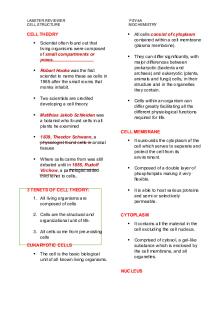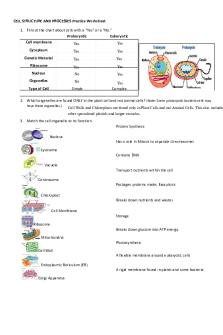Cell Structure and Magnification PPQ PDF

| Title | Cell Structure and Magnification PPQ |
|---|---|
| Author | Naimah Shakeel |
| Course | Cell Biology |
| Institution | Coventry University |
| Pages | 28 |
| File Size | 1.4 MB |
| File Type | |
| Total Downloads | 8 |
| Total Views | 141 |
Summary
kmnj,...
Description
Cell Structure and Magnification PPQ Q1. A bacterium is shown in the diagram.
(a)
Calculate the magnification of the image.
Magnification = _________________ (1)
(b)
Complete the table to show the features of a bacterium and a virus. Put a tick (✔) in the box if the feature is shown. Surface
Bacterium
Virus
Cell-surface membrane Nucleus Cytoplasm Capsid (2)
(c)
DNA and RNA can be found in bacteria. Give two ways in which the nucleotides in DNA are different from the nucleotides in RNA. 1. _________________________________________________________________ 2. _________________________________________________________________ (2)
(Total 5 marks)
Q2. (a)
Describe how you could use cell fractionation to isolate chloroplasts from leaf tissue. ___________________________________________________________________ ___________________________________________________________________ ___________________________________________________________________ ___________________________________________________________________ ___________________________________________________________________ ___________________________________________________________________ (Extra space) _______________________________________________________ ___________________________________________________________________ (3)
The figure below shows a photograph of a chloroplast taken with an electron microscope.
© Science Photo Library
(b)
Name the parts of the chloroplast labelled A and B. Name of A ________________________________________________________ Name of B ________________________________________________________ (2)
(c)
Calculate the length of the chloroplast shown in the figure above.
Answer ____________________ (1)
(d)
Name two structures in a eukaryotic cell that cannot be identified using an optical microscope. 1. _________________________________________________________________ 2. _________________________________________________________________ (1) (Total 7 marks)
Q3. (a)
Describe how you could make a temporary mount of a piece of plant tissue to observe the position of starch grains in the cells when using an optical (light) microscope. ___________________________________________________________________ ___________________________________________________________________ ___________________________________________________________________ ___________________________________________________________________ ___________________________________________________________________ ___________________________________________________________________ ___________________________________________________________________ ___________________________________________________________________ (Extra space) _______________________________________________________ ___________________________________________________________________ ___________________________________________________________________ (4)
The figure below shows a microscopic image of a plant cell.
© Science Photo Library
(b)
Give the name and function of the structures labelled W and Z. Name of W__________________________________________________________ Function of W________________________________________________________ Name of Z __________________________________________________________ Function of Z ________________________________________________________ (2)
(c)
A transmission electron microscope was used to produce the image in the figure above. Explain why. ___________________________________________________________________ ___________________________________________________________________ ___________________________________________________________________ ___________________________________________________________________ ___________________________________________________________________ (2)
(d)
Calculate the magnification of the image shown in the figure in part (a).
Answer = ____________________ (1) (Total 9 marks)
Q4. The diagram shows a cholera bacterium. It has been magnified 50 000 times.
(a)
Name A. ___________________________________________________________________ (1)
(b)
Name two structures present in an epithelial cell from the small intestine that are not present in a cholera bacterium. 1. _________________________________________________________________ 2. _________________________________________________________________ (2)
(c)
Cholera bacteria can be viewed using a transmission electron microscope (TEM) or a scanning electron microscope (SEM). (i)
Give one advantage of using a TEM rather than a SEM. ______________________________________________________________ ______________________________________________________________ (1)
(ii)
Give one advantage of using a SEM rather than a TEM. ______________________________________________________________ ______________________________________________________________ ______________________________________________________________ (1)
(d)
Calculate the actual width of the cholera bacterium between points B and C. Give your answer in micrometres and show your working.
____________________ µm (2)
(e)
An outbreak of cholera occurred in London in 1849. The graph shows the relationship between the number of deaths from cholera and the height at which people lived above sea level.
Describe the relationship between the number of deaths from cholera and the height at which people lived above sea level. ___________________________________________________________________ ___________________________________________________________________ ___________________________________________________________________ ___________________________________________________________________ ___________________________________________________________________ (2) (Total 9 marks)
Q5. (a)
The table below shows features of a bacterium and the human immunodeficiency virus (HIV) particle. Complete the table by putting a tick (✔) where a feature is present.
Feature
Bacterium
Human immunodeficiency virus (HIV) particle
RNA Cell wall Enzyme molecules Capsid (2)
(b)
When HIV infects a human cell, the following events occur. • •
A single-stranded length of HIV DNA is made. The human cell then makes a complementary strand to the HIV DNA.
The complementary strand is made in the same way as a new complementary strand is made during semi-conservative replication of human DNA. Describe how the complementary strand of HIV DNA is made. ___________________________________________________________________ ___________________________________________________________________ ___________________________________________________________________ ___________________________________________________________________ ___________________________________________________________________ ___________________________________________________________________ ___________________________________________________________________ ___________________________________________________________________ ___________________________________________________________________ (3)
(c)
Contrast the structures of DNA and mRNA molecules to give three differences. 1. _________________________________________________________________ ___________________________________________________________________ 2. _________________________________________________________________ ___________________________________________________________________ 3. _________________________________________________________________ ___________________________________________________________________ (3) (Total 8 marks)
Q6. (a)
Name the type of bond that joins amino acids together in a polypeptide. ___________________________________________________________________ (1)
The diagram shows a cell from the pancreas.
(b)
The cytoplasm at F contains amino acids. These amino acids are used to make proteins which are secreted from the cell. Place the appropriate letters in the correct order to show the passage of an amino acid from the cytoplasm at F until it is secreted from the cell as a protein at K.
F
K (2)
(c)
There are lots of organelle G in this cell. Explain why. ___________________________________________________________________ ___________________________________________________________________ ___________________________________________________________________ ___________________________________________________________________ (2)
(d)
A group of scientists homogenised pancreatic tissue before carrying out cell fractionation to isolate organelle G. Explain why the scientists (i)
homogenised the tissue ______________________________________________________________ ______________________________________________________________ (1)
(ii)
filtered the resulting suspension
______________________________________________________________ ______________________________________________________________ (1)
(iii)
kept the suspension ice cold during the process ______________________________________________________________ ______________________________________________________________ (1)
(iv)
used isotonic solution during the process. ______________________________________________________________ ______________________________________________________________ ______________________________________________________________ ______________________________________________________________ (2) (Total 10 marks)
Q7. (a)
The table shows some parts of cells and two different types of cell. Complete the table by putting a tick in a box if the structure is present in the type of cell. Cell wall
Cell-surface membrane
Nucleus
White blood cell Bacterial cell (2)
(b)
The diagram is of a mitochondrion at a magnification of × 30 000.
Calculate the actual length of this mitochondrion in micrometres (µm). Show your working.
Answer = ____________________ µm (2)
(c)
Some scientists support the theory that mitochondria are organelles that evolved from prokaryotic cells. (i)
Give one piece of evidence that supports the theory that mitochondria evolved from prokaryotic cells. ______________________________________________________________ ______________________________________________________________ ______________________________________________________________ (1)
(ii)
What is the advantage to cells of having mitochondria? ______________________________________________________________ ______________________________________________________________ ______________________________________________________________ ______________________________________________________________ ______________________________________________________________ (2) (Total 7 marks)
Q8. A scientist examined the structure of mustard plant leaves. He viewed temporary mounts of leaf tissues with an optical microscope. The figure below shows a drawing of typical results.
(a)
Describe how temporary mounts are made. ___________________________________________________________________ ___________________________________________________________________ ___________________________________________________________________ ___________________________________________________________________ ___________________________________________________________________ (2)
(b)
Calculate the distance in micrometres between G and H on the leaf.
Answer = ____________________ µm (2)
(c)
Describe how the scientist could have used the temporary mounts of leaves to determine the mean number of chloroplasts in mesophyll cells of a leaf. ___________________________________________________________________ ___________________________________________________________________ ___________________________________________________________________ ___________________________________________________________________ ___________________________________________________________________ ___________________________________________________________________ ___________________________________________________________________ (3) (Total 7 marks)
Q9. The diagram shows a eukaryotic cell.
(a)
Complete the table by giving the letter labelling the organelle that matches the function. Function of organelle Protein synthesis Modifies protein (for example, adds carbohydrate to
Letter
protein) Aerobic respiration (3)
(b)
Use the scale bar in the diagram above to calculate the magnification of the drawing. Show your working.
Answer = ____________________ (2) (Total 5 marks)
Q10. (a)
Describe how phospholipids are arranged in a plasma membrane. ___________________________________________________________________ ___________________________________________________________________ ___________________________________________________________________ ___________________________________________________________________ (2)
(b)
Cells that secrete enzymes contain a lot of rough endoplasmic reticulum (RER) and a large Golgi apparatus. (i)
Describe how the RER is involved in the production of enzymes. ______________________________________________________________ ______________________________________________________________ ______________________________________________________________ ______________________________________________________________ (2)
(ii)
Describe how the Golgi apparatus is involved in the secretion of enzymes. ______________________________________________________________ ______________________________________________________________ ______________________________________________________________ (1) (Total 5 marks)
Q11.
The diagram shows the structure of the cell-surface membrane of a cell.
(a)
Name A and B. A _________________________________________________________________ B _________________________________________________________________ (2)
(b)
(i)
C is a protein with a carbohydrate attached to it. This carbohydrate is formed by joining monosaccharides together. Name the type of reaction that joins monosaccharides together. Name the type of reaction that joins monosaccharides together. ______________________________________________________________ (1)
(ii)
Some cells lining the bronchi of the lungs secrete large amounts of mucus. Mucus contains protein. Name one organelle that you would expect to find in large numbers in a mucus-secreting cell and describe its role in the production of mucus. Organelle______________________________________________________ Description of role _______________________________________________ ______________________________________________________________ ______________________________________________________________ ______________________________________________________________ (2) (Total 5 marks)
Q12. The photograph shows part of the cytoplasm of a cell.
(a)
(i)
Organelle X is a mitochondrion. What is the function of this organelle? ______________________________________________________________ ______________________________________________________________ (1)
(ii)
Name organelle Y. ______________________________________________________________ (1)
(b)
This photograph was taken using a transmission electron microscope. The structure of the organelles visible in the photograph could not have been seen using an optical(light) microscope. Explain why. ___________________________________________________________________ ___________________________________________________________________ ___________________________________________________________________ ___________________________________________________________________ ___________________________________________________________________ (2) (Total 4 marks)
Q13. (a)
The table shows some statements about three carbohydrates. Complete the table with a tick in each box if the statement is true. Statement Found in plant cells
Starch
Cellulose
Glycogen
Contains glycosidic bonds Contains β-glucose (3)
(b)
Name the type of reaction that would break down these carbohydrates into their monomers. ___________________________________________________________________ (1)
(c)
Give one feature of starch and explain how this feature enables it to act as a storage substance. Feature ____________________________________________________________ Explanation _________________________________________________________ ___________________________________________________________________ ___________________________________________________________________ (2)
(d)
The picture shows starch grains as seen with an optical microscope. The actual length of starch grain A is 48 μm. Use this information and the arrow line to calculate the magnification of the picture. Show your working.
© iStock/Thinkstock
Magnification ____________________ times (2) (Total 8 marks)
Q14. An amoeba is a single-celled, eukaryotic organism. Scientists used a transmission electron microscope to study an amoeba. The diagram shows its structure.
(a)
(i)
Name organelle Y. ______________________________________________________________ (1)
(ii)
Name two other structures in the diagram which show that the amoeba is a eukaryotic cell. 1. ____________________________________________________________ 2. ____________________________________________________________ (2)
(b)
What is the function of organelle Z? ___________________________________________________________________ ___________________________________________________________________ ___________________________________________________________________ (1)
(c)
The scientists used a transmission electron microscope to study the structure of the amoeba. Explain why. (2) (Total 6 marks)
Q15. The diagram shows part of an epithelial cell from an insect’s gut.
This cell is adapted for the three functions listed below. Use the diagram to explain how this cell is adapted for each of these functions. Use a different feature in the diagram for each of your answers. (a)
the active transport of substances from the cell into the blood ___________________________________________________________________ ___________________________________________________________________ ___________________________________________________________________ ___________________________________________________________________ ___________________________________________________________________ ___________________________________________________________________ (2)
(b)
the synthesis of enzymes ___________________________________________________________________ ___________________________________________________________________ _______________________...
Similar Free PDFs

Cell Structure and Magnification PPQ
- 28 Pages

Cell Structure SE 1
- 3 Pages

Labster 1 cell structure
- 10 Pages

Cell Structure (reviewer)
- 7 Pages

Structure of generalized cell
- 2 Pages

Cell Structure Worksheet
- 1 Pages

Cell Structure notes
- 13 Pages

Cell Structure Practice
- 3 Pages

CELL Structure OF Microorganisms
- 7 Pages

Prokaryotic Cell Structure
- 4 Pages

Cell Structure worksheet
- 3 Pages

Cell Structure and fucntion part 1
- 14 Pages
Popular Institutions
- Tinajero National High School - Annex
- Politeknik Caltex Riau
- Yokohama City University
- SGT University
- University of Al-Qadisiyah
- Divine Word College of Vigan
- Techniek College Rotterdam
- Universidade de Santiago
- Universiti Teknologi MARA Cawangan Johor Kampus Pasir Gudang
- Poltekkes Kemenkes Yogyakarta
- Baguio City National High School
- Colegio san marcos
- preparatoria uno
- Centro de Bachillerato Tecnológico Industrial y de Servicios No. 107
- Dalian Maritime University
- Quang Trung Secondary School
- Colegio Tecnológico en Informática
- Corporación Regional de Educación Superior
- Grupo CEDVA
- Dar Al Uloom University
- Centro de Estudios Preuniversitarios de la Universidad Nacional de Ingeniería
- 上智大学
- Aakash International School, Nuna Majara
- San Felipe Neri Catholic School
- Kang Chiao International School - New Taipei City
- Misamis Occidental National High School
- Institución Educativa Escuela Normal Juan Ladrilleros
- Kolehiyo ng Pantukan
- Batanes State College
- Instituto Continental
- Sekolah Menengah Kejuruan Kesehatan Kaltara (Tarakan)
- Colegio de La Inmaculada Concepcion - Cebu



